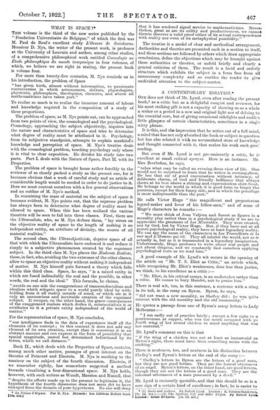WHAT IS SPACE ?* THIS volume is the third of
the new series published by the " Fondation Universitaire de Belgique," of which the first was M. Paul de Reul's excellent study L'Oeuvre de Swinburne. Monsieur D. Nys, the writer of the present work, is professor at the University of Louvain and author, among other studies, of a comprehensive philosophical work entitled Cosmologie ou Etude philosophique du monde inorganique in four volumes, of
which, we believe we are right in stating, the present book is volume four.
For more than twenty-five centuries, M. Nys reminds us in his introduction, the problem of Space
"has given birth, almost without interruption, to passionate controversies in which astronomers, doctors, physiologists, physicists, philosophers, theologians, chemists, and above all mathematicians have taken part."
To realize so much is to realize the immense amount of labour and knowledge required in the composition of a study of these proportions.
The problem of space, as M. Nys points out, can be approached from two points of view, the cosmological and the psychological. Cosmology, approaching the subject objectively, inquires into the nature and characteristics of space and tries to determine what degree of reality must be attributed to it. Psychology, from its subjective standpoint, attempts to explain mankind's
knowledge and perception of space. M. Nys's treatise deals with the cosmological problem, touching psychology only where it is vital to clear exposition. He divides his study into two
parts. Part L deals with the Nature of Space, Part IL with its Properties.
The problem of space is brought home rather forcibly to the reviewer of so closely packed a study as the present one, for it becomes obvious that a week of careful study and an article of considerable length would be needed in order to do justice to it. Here we must content ourselves with a few general observations and an outline of M. Nys's method.
In examining the mass of material on the subject of space it becomes evident, M. Nys points out, that the supreme problem
has always been to determine what degree of reality must be allowed to space. When this has been realized the various theorists will be seen to fall into three classes. First, there are the Ultrarealists, who, as M. Nys defines them, "lay stress on the objective reality of space to the length of making it an independent entity, an attribute of divinity, the source of all
material realities."
The second class, the Ultrasubjectivists, deprive space of all that with which the Ultrarealists have endowed it and reduce it simply to a subjective phenomenon created by the cognisant subject. In the third class M. Nys places the Moderate Realists, those, in fact, who, avoiding the two extremes of the other classes,
allow to space an objective reality without making it independent of matter. M. Nys himself puts forward a theory which falls within this third class. Space, he says, "is a mixed entity in which are fused indissolubly the real and the possible, in other words, the real and the ideal." This formula, he claims,
"avoids on one side the exaggerations of transcendentalism and idealism which relegate space to a world purely ideal by with- holding from it all reality outside of mind, or which see in it only an unconscious and inevitable creation of the cognisant subject. It escapes, on the other hand, the grave consequences of the exaggerated realism which deifies it, substantialises it or attributes to it a private entity independent of the world of matter."
For the representation of space, M. Nys concludes,
"our intelligence finds in the data of experience itself all the elements of its concept ; to this content it does not add any element of its own creation, except that it conceives it in an abstract manner and can express in the form of possibility that spatial magnitude, unreal but determined beforehand by its terms, which we call distance."
Book IL, which deals with the Properties of Space, contains, among much other matter, passages of great interest on the theories of Poincare and Einstein. M. Nys is soothing to the
amateur on the subject of the fourth dimension. Einstein, if we remember rightly, has somewhere suggested a method towards visualizing a four-dimensional space. M. Nys holds, however, with such writers as Wundt, Mansion and Russell, that "despite the efforts made up to the present to legitimise it, the hypothesis of the fourth dimension does not seem yet to have emerged from the domain of pure hypotheses. No one will deny • La Notion d'Espace. Par D. Nys. Brussels: Les Editions Robert Sand. net.]
that it has rendered signal service to mathematicians. Never. theless, great as are its utility and productiveness, we cannot therein discover a valid proof either of its actual correspondence with reality nor even of its metaphysical possibility."
The treatise is a model of clear and methodical arrangement. Authorities and theories are presented each in a section to itself, and these sections are followed by others which draw appropriate conclusions, define the objections which may be brought against
these authorities or theories, or unfold briefly and clearly a
general criticism of them. The result is a lucid and orderly structure which exhibits the subject in a form free from all unnecessary complexity and so enables the reader .to give undivided attention to the subject-matter.






































 Previous page
Previous page